Resurrecting rare mosses at Aberffraw Flagship Pond site
6th February 2017
People, Ponds & Water officer Hannah Shaw describes work to resurrect the dune slack specialist mosses Broad-nerved Hump Moss and Matted Bryum at a Flagship Pond site in Wales.
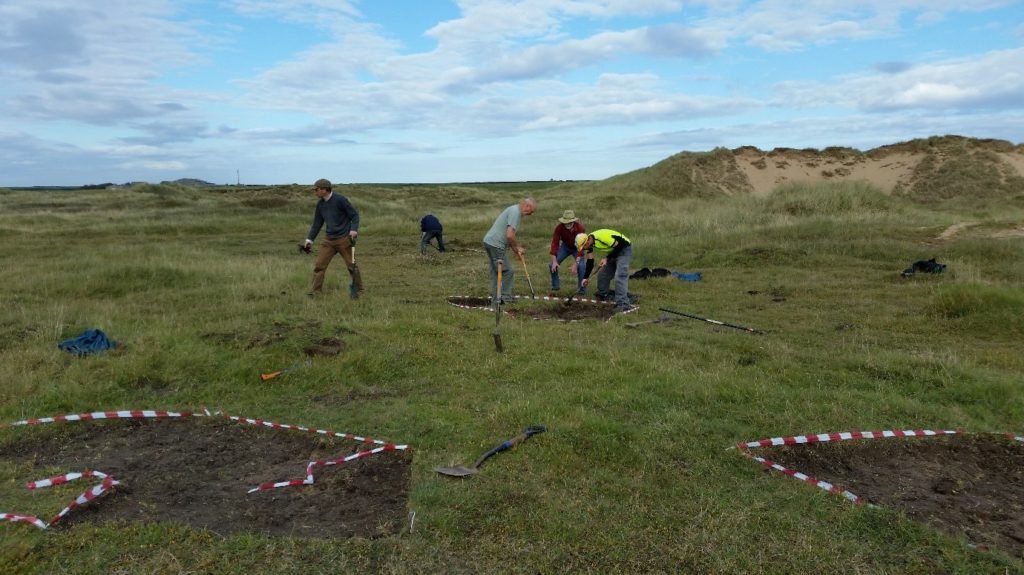
In October 2016, vital ‘emergency’ works were undertaken by Anglesey AONB volunteers as part of the Flagship Pond project, with partners Natural Resources Wales (NRW) and Keep Wales Tidy.
Tywyn Aberffraw Site of Special Scientific Interest (SSSI) is owned by the Bodorgan Estate and is part of the larger Abermenai to Aberffraw Dunes Special Area of Conservation (SAC) which also includes Newborough Warren. Tywyn Aberffraw supports the most species-rich assemblage of dune slack bryophytes (mosses and liverworts) in Wales and, until recently, the sand dune system covering Aberffraw was considered to be the best example in Wales. However, in the last few years there has been concern at the (natural) increasing stabilisation of the dunes and the build-up of vegetation in the dune slacks.
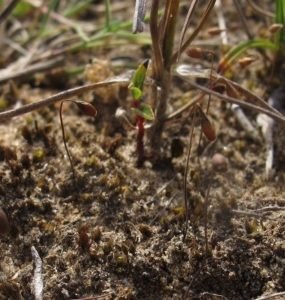
This stabilisation has resulted in the decline and extinction of at least two rare mosses for which Tywyn Aberffraw was the sole/last location in Wales. The strangely named Broad-nerved Hump Moss (Meesia uliginosa), and a thread-moss, Matted Bryum (Bryum calophyllum) are believed to have recently become extinct at Tywyn Aberffraw as neither species have been seen since 2001, despite extensive searches. The habitat is no longer considered suitable. In addition, there are a further two rare dune slack bryophyte species at Tywyn Aberffraw; another thread moss, Sea Bryum (Bryum warneum) and the liverwort, Petalwort (Petalophyllum ralfsii) which are still present but only just ‘hanging on’.
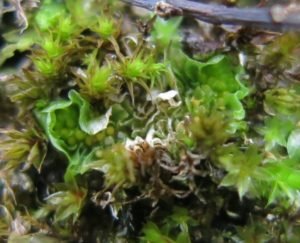
These four species are listed on Section 7 of the Environment (Wales) Act 2016 which is a list of the ‘Living organisms of principal importance for the purpose of maintaining and enhancing biodiversity in relation to Wales’ (formerly the Priority BAP and NERC Act 2006 Section 42 species).
All of these species are dependent on early stage dune slacks but much of this habitat has now disappeared from Tywyn Aberffraw through natural succession and stabilisation of the dune slacks by the colonisation of the bare ground by vegetation. The dune slacks are seasonally flooded depressions in the sand dunes and those formed at the rear of the dunes are freshwater ponds that often only hold water in the winter, and when dry, provide damp areas of bare sand which are so important for these rare bryophytes that specialise in this type of habitat.
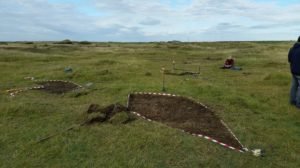
With permission from the Bodorgan Estate, who own and protect the common and with the agreement of the graziers, the necessary SSSI consents obtained from NRW, and following detailed discussion with NRW’s bryophyte expert Sam Bosanquet, on the 12th October 2016, the turf was stripped off seven small areas of the slack and one area was raked to remove the shallow-rooted vegetation to provide areas of bare sand between the remaining sedges and dwarf willow. The works were undertaken by the Anglesey AONB volunteers, Gareth Owen of Keep Wales Tidy, Hannah Shaw of Freshwater Habitats Trust, and Sam Bosquanet & John Ratcliffe of NRW. It is anticipated that these works have reversed the sand dune succession process by 20 years in these small areas and have provided new bare sand for these pioneer bryophyte species. It is hoped that the spores for these species are still present in the locality and that following the winter flooding, these species will naturally recolonise from the spore bank. We won’t know the result of these works for at least a year or more.
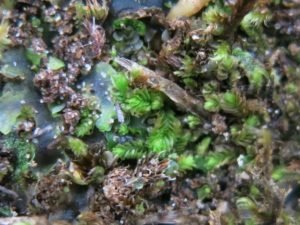
Immediately prior to the works starting Sam Bosanquet identified the areas to be turf-stripped by very carefully searching the dune slack for other notable species that were to be avoided during the works. The boundaries of the chosen areas were marked with red and white tape. Species avoided included: petalwort, Southbya tophacea and Adders-tongue fern Ophioglossum vulgatum.
In total, the Anglesey AONB volunteers, helped by John Ratcliffe and Hannah Shaw removed the vegetated turf layer from the following areas searched and marked out by Sam Bosanquet – six small areas and one narrow linear feature – and an additional small area was raked to remove the bryophyte layer and expose bare sand between the sedges and dwarf willow.
These works are considered to be ‘emergency works’ to restore these species to Tywyn Aberffraw, ahead of a potential larger project that is still at the planning stage. It is hoped that over the winter the dune slack will flood and these bare areas will provide suitable habitat for the rare bryophytes to grow in the future.
The Flagship Pond project, which works with local communities and organisations to take care of out finest ponds, is part of People, Ponds and Water, funded by the Heritage Lottery Fund
Want to know more?
- Find out more about the 70 Flagship Pond sites we are working on across England and Wales
